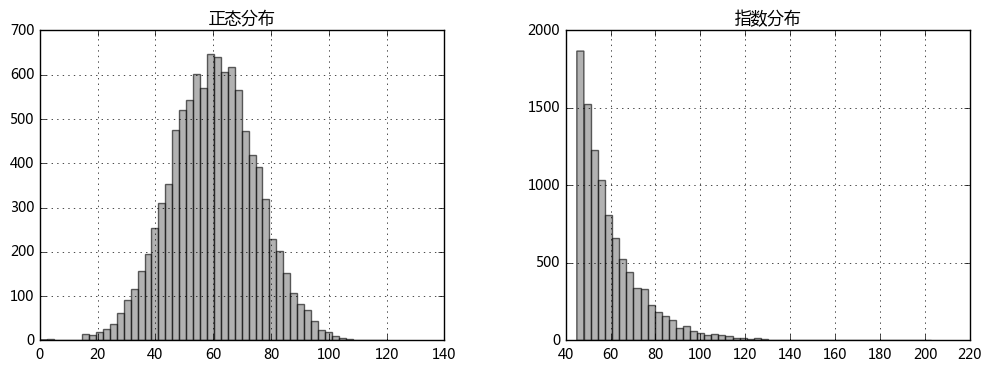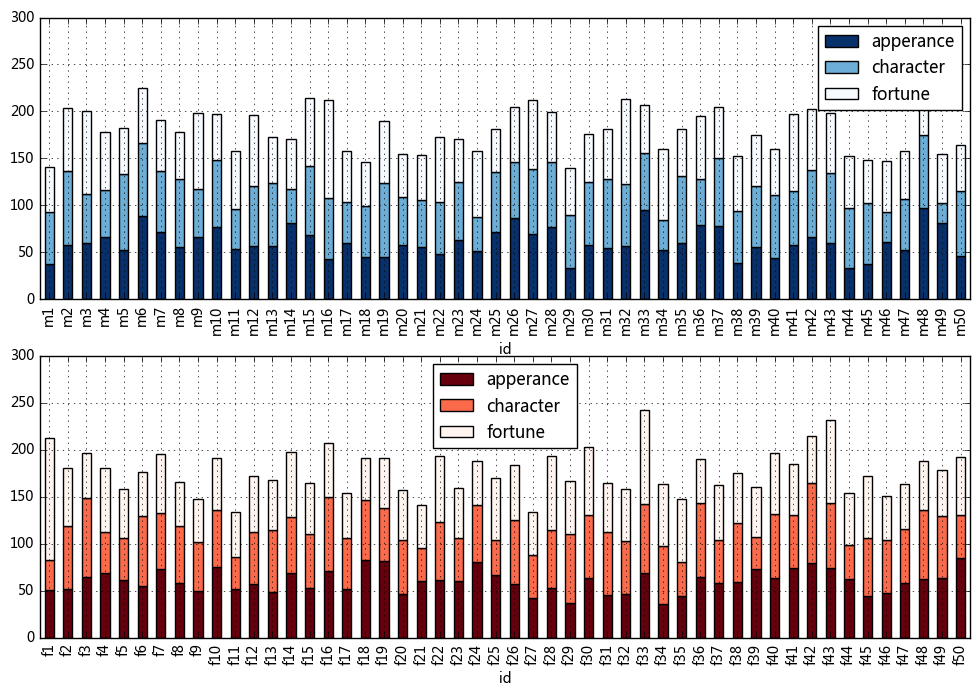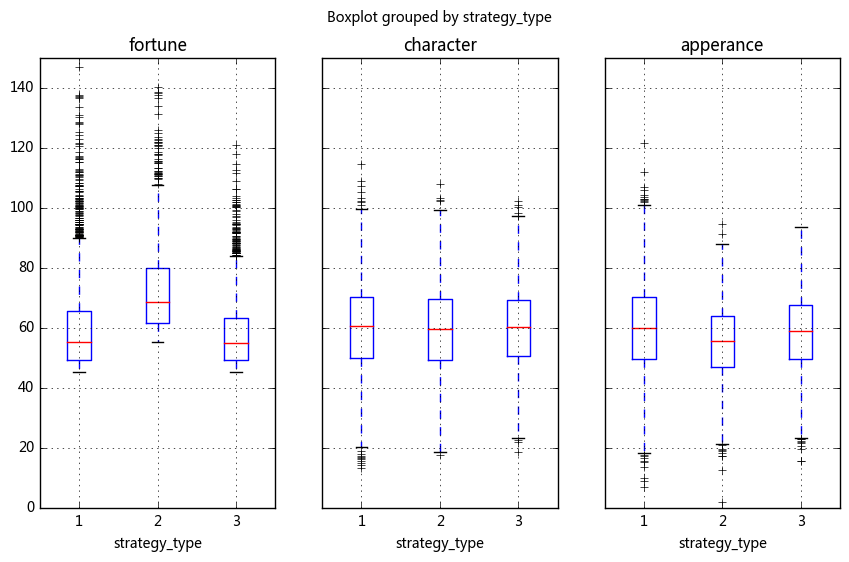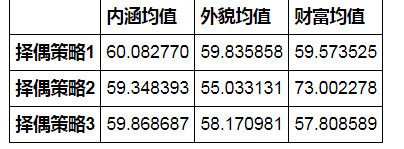婚恋配对实验
婚恋配对实验 婚恋配对模拟规则: ① 按照一定规则生成了1万男性+1万女性样本: ** 在配对实验中,这2万个样本具有各自不同的个人属性(财富、内涵、外貌),每项属性都有一个得分 ** 财富值符合指数分布,内涵和颜值符合正态分布 ** 三项的平均值都为60分,标准差都为15分 ② 模拟实验。基于现实世界的提炼及适度简化,我们概括了三个最主流的择偶策略: ** 择偶策略1:门当户对,要求双方三项指标加和的总分接近,差值不超过20分; ** 择偶策略2:男才女貌,男性要求女性的外貌分比自己高出至少10分,女性要求男性的财富分比自己高出至少10分; ** 择偶策略3:志趣相投、适度引领,要求对方的内涵得分在比自己低5分~高10分的区间内,且外貌和财富两项与自己的得分差值都在5分以内 ③ 每一轮实验中,我们将三种策略随机平分给所有样本(即采用每种策略的男性有3333个样本) ④ 我们为每位单身男女随机选择一个对象,若双方互相符合要求就算配对成功,配对失败的男女则进入下一轮配对。 1、样本数据处理 ** 按照一定规则生成了1万男性+1万女性样本: ** 在配对实验中,这2万个样本具有各自不同的个人属性(财富、内涵、外貌),每项属性都有一个得分 ** 财富值符合指数分布,内涵和颜值符合正态分布 ** 三项的平均值都为60分,标准差都为15分 要求: ① 构建函数实现样本数据生成模型,函数参数之一为“样本数量”,并用该模型生成1万男性+1万女性数据样本 ** 包括三个指标:财富、内涵、外貌 ② 绘制柱状图来查看每个人的属性分值情况 提示: ① 正态分布:np.random.normal(loc=60, scale=15, size=n) ② 指数分布:np.random.exponential(scale=15, size=n) + 45 2、生成99个男性、99个女性样本数据,分别针对三种策略构建算法函数 ** 择偶策略1:门当户对,要求双方三项指标加和的总分接近,差值不超过20分; ** 择偶策略2:男才女貌,男性要求女性的外貌分比自己高出至少10分,女性要求男性的财富分比自己高出至少10分; ** 择偶策略3:志趣相投、适度引领,要求对方的内涵得分在比自己低10分~高10分的区间内,且外貌和财富两项与自己的得分差值都在5分以内 ** 每一轮实验中,我们将三种策略随机平分给所有样本,这里则是三种策略分别33人 ** 这里不同策略匹配结果可能重合,所以为了简化模型 → 先进行策略1模拟, → 模拟完成后去掉该轮成功匹配的女性数据,再进行策略2模拟, → 模拟完成后去掉该轮成功匹配的女性数据,再进行策略3模拟 ① 生成样本数据 ② 给男性样本数据,随机分配策略选择 → 这里以男性为出发作为策略选择方 ③ 尝试做第一轮匹配,记录成功的匹配对象,并筛选出失败的男女性进入下一轮匹配 ④ 构建模型,并模拟1万男性+1万女性的配对实验 ⑤ 通过数据分析,回答几个问题: ** 百分之多少的样本数据成功匹配到了对象? ** 采取不同择偶策略的匹配成功率分别是多少? ** 采取不同择偶策略的男性各项平均分是多少? 提示: ① 择偶策略评判标准: ** 若匹配成功,则该男性与被匹配女性在这一轮都算成功,并退出游戏 ** 若匹配失败,则该男性与被匹配女性再则一轮都算失败,并进入下一轮 ** 若同时多个男性选择了同一个女性,且满足成功配对要求,则综合评分高的男性算为匹配成功 ② 构建空的数据集,用于存储匹配成功的数据 ③ 每一轮匹配之后,删除成功匹配的数据之后,进入下一轮,这里删除数据用df.drop() ④ 这里建议用while去做迭代 → 当该轮没有任何配对成功,则停止实验 3、以99男+99女的样本数据,绘制匹配折线图 要求: ① 生成样本数据,模拟匹配实验 ② 生成绘制数据表格 ③ bokhe制图 ** 这里设置图例,并且可交互(消隐模式) 提示: ① bokeh制图时,y轴为男性,x轴为女性 ② 绘制数据表格中,需要把男女性的数字编号提取出来,这样图表横纵轴好识别 ③ bokhe绘制折线图示意:p.line([0,女性数字编号,女性数字编号],[男性数字编号,男性数字编号,0]) 4、生成“不同类型男女配对成功率”矩阵图 要求: ① 以之前1万男+1万女实验的结果为数据 ② 按照财富值、内涵值、外貌值分别给三个区间,以区间来评判“男女类型” ** 高分(70-100分),中分(50-70分),低分(0-50分) ** 按照此类分布,男性女性都可以分为27中类型:财高品高颜高、财高品中颜高、财高品低颜高、... (财→财富,品→内涵,颜→外貌) ③ bokhe制图 ** 散点图 ** 27行*27列,散点的颜色深浅代表匹配成功率 提示: ① 注意绘图的数据结构 ② 这里散点图通过xy轴定位数据,然后通过设置颜色的透明度来表示匹配成功率 ③ alpha字段为每种类型匹配成功率标准化之后的结果,再乘以一个参数 → data['alpha'] = (data['chance'] - data['chance'].min())/(data['chance'].max() - data['chance'].min())*8
import numpy as np import pandas as pd import matplotlib.pyplot as plt import os import time # 导入时间模块 import warnings warnings.filterwarnings('ignore') # 不发出警告 from bokeh.io import output_notebook output_notebook() # 导入notebook绘图模块 from bokeh.plotting import figure,show from bokeh.models import ColumnDataSource,HoverTool # 导入bokeh绘图模块
1、样本数据处理 ** 按照一定规则生成了1万男性+1万女性样本: ** 在配对实验中,这2万个样本具有各自不同的个人属性(财富、内涵、外貌),每项属性都有一个得分 ** 财富值符合指数分布,内涵和颜值符合正态分布 ** 三项的平均值都为60分,标准差都为15分 要求: ① 构建函数实现样本数据生成模型,函数参数之一为“样本数量”,并用该模型生成1万男性+1万女性数据样本 ** 包括三个指标:财富、内涵、外貌 ② 绘制柱状图来查看每个人的属性分值情况 提示: ① 正态分布:np.random.normal(loc=60, scale=15, size=n) ② 指数分布:np.random.exponential(scale=15, size=n) + 45
# 分别生成1万条随机数据,分别为正态分布、指数分布,要求数据均值为60,标准差为15 data_norm = pd.DataFrame({'正态分布':np.random.normal(loc = 60,scale = 15,size = 10000)}) data_exp = pd.DataFrame({'指数分布':np.random.exponential(scale=15, size=10000) + 45}) # 构建样本数据 → 正态分布/指数分布 fig,axes = plt.subplots(1,2,figsize = (12,4)) data_norm.hist(bins=50,ax = axes[0],grid = True,color = 'gray',alpha = 0.6) data_exp.hist(bins = 50,ax = axes[1],grid = True,color = 'gray',alpha = 0.6) plt.show()

# 构建函数实现样本数据生成模型,函数参数之一为“样本数量”,并用该模型生成1万男性+1万女性数据样本 def create_sample(n,gender): sample_data = pd.DataFrame({'fortune':np.random.exponential(scale=15, size=n) + 45, 'apperance':np.random.normal(loc = 60,scale = 15,size = n), 'character':np.random.normal(loc = 60,scale = 15,size = n)}, index = [gender + str(i) for i in range(1,n+1)]) sample_data.index.name = 'id' sample_data['score'] = sample_data.sum(axis = 1)/3 # 计算综合评分 return sample_data # 创建函数 sample_m = create_sample(10000,'m') sample_f = create_sample(10000,'f') # 生成男女样本数据 fig,axes = plt.subplots(2,1,figsize = (12,8)) sample_m[['apperance','character','fortune']].iloc[:50].plot(kind='bar',colormap='Blues_r',grid = True,stacked=True,ax = axes[0],ylim = [0,300]) sample_f[['apperance','character','fortune']].iloc[:50].plot(kind='bar',colormap='Reds_r',grid = True,stacked=True,ax = axes[1],ylim = [0,300]) plt.show() # 出图查看数据 sample_m.head() # 查看男性样本数据分布

2、生成99个男性、99个女性样本数据,分别针对三种策略构建算法函数 ** 择偶策略1:门当户对,要求双方三项指标加和的总分接近,差值不超过20分; ** 择偶策略2:男才女貌,男性要求女性的外貌分比自己高出至少10分,女性要求男性的财富分比自己高出至少10分; ** 择偶策略3:志趣相投、适度引领,要求对方的内涵得分在比自己低10分~高10分的区间内,且外貌和财富两项与自己的得分差值都在5分以内 ** 每一轮实验中,我们将三种策略随机平分给所有样本,这里则是三种策略分别33人 ** 这里不同策略匹配结果可能重合,所以为了简化模型 → 先进行策略1模拟, → 模拟完成后去掉该轮成功匹配的女性数据,再进行策略2模拟, → 模拟完成后去掉该轮成功匹配的女性数据,再进行策略3模拟 要求: ① 生成样本数据 ② 给男性样本数据,随机分配策略选择 → 这里以男性为出发作为策略选择方 ③ 尝试做第一轮匹配,记录成功的匹配对象,并筛选出失败的男女性进入下一轮匹配 ④ 构建模型,并模拟1万男性+1万女性的配对实验 ⑤ 通过数据分析,回答几个问题: ** 百分之多少的样本数据成功匹配到了对象? ** 采取不同择偶策略的匹配成功率分别是多少? ** 采取不同择偶策略的男性各项平均分是多少? 提示: ① 择偶策略评判标准: ** 若匹配成功,则该男性与被匹配女性在这一轮都算成功,并退出游戏 ** 若匹配失败,则该男性与被匹配女性再则一轮都算失败,并进入下一轮 ** 若同时多个男性选择了同一个女性,且满足成功配对要求,则综合评分高的男性算为匹配成功 ② 构建空的数据集,用于存储匹配成功的数据 ③ 每一轮匹配之后,删除成功匹配的数据之后,进入下一轮,这里删除数据用df.drop() ④ 这里建议用while去做迭代 → 当该轮没有任何配对成功,则停止实验
# 这里先生成99个男性、99个女性样本数据 sample_m_test = create_sample(99,'m') sample_f_test = create_sample(99,'f') # 设置好样本数据 sample_m_test['strategy'] = np.random.choice([1,2,3],99) # 给男性赋值策略选择 # 1 → 择偶策略1 # 2 → 择偶策略2 # 3 → 择偶策略3
# 择偶策略,测试 match_success = pd.DataFrame(columns = ['m','f','round_n','strategy_type']) # 构建空的数据集,用于存储匹配成功的数据 round1_f = sample_f_test.copy() # 复制女性样本数据 round1_m = sample_m_test.copy() round1_m['choice'] = np.random.choice(round1_f.index,len(round1_m)) # 复制男性样本数据,并做匹配选择 round1_match = pd.merge(round1_m,round1_f,left_on = 'choice',right_index = True).reset_index() round1_match['score_dis'] = np.abs(round1_match['score_x'] - round1_match['score_y']) # 计算综合评分差值 round1_match['cha_dis'] = np.abs(round1_match['character_x'] - round1_match['character_y']) # 求出内涵得分差值 round1_match['for_dis'] = np.abs(round1_match['fortune_x'] - round1_match['fortune_y']) # 求出财富得分差值 round1_match['app_dis'] = np.abs(round1_match['apperance_x'] - round1_match['apperance_y']) # 求出外貌得分差值 # 合并数据 # ① 策略1:门当户对,要求双方三项指标加和的总分接近,差值不超过20分; round1_s1_m = round1_match[round1_match['strategy'] == 1] # 筛选策略1的数据 round1_s1_success = round1_s1_m[round1_s1_m['score_dis'] <= 20].groupby('choice').max() # 筛选符合要求的数据 round1_s1_success = pd.merge(round1_s1_success,round1_m.reset_index(),left_on = 'score_x',right_on = 'score')[['id_y','choice']] round1_s1_success.columns = ['m','f'] round1_s1_success['strategy_type'] = 1 round1_s1_success['round_n'] = 1 # 得到策略1的成功匹配的结果 round1_match.index = round1_match['choice'] round1_match = round1_match.drop(round1_s1_success['f'].tolist()) # 删除策略1成功匹配的女性数据 # ② 策略2:男才女貌,男性要求女性的外貌分比自己高出至少10分,女性要求男性的财富分比自己高出至少10分; round1_s2_m = round1_match[round1_match['strategy'] == 2] # 筛选策略2的数据 round1_s2_success = round1_s2_m[(round1_s2_m['fortune_x'] - round1_s2_m['fortune_y'] >= 10) & # 男性财富比女性高出至少10分 (round1_s2_m['apperance_y'] - round1_s2_m['apperance_x'] >= 10)] # 女性颜值比男性高出至少10分 round1_s2_success = round1_s2_success.groupby('choice').max() # 筛选符合要求的数据 round1_s2_success = pd.merge(round1_s2_success,round1_m.reset_index(),left_on = 'score_x',right_on = 'score')[['id_y','choice']] round1_s2_success.columns = ['m','f'] round1_s2_success['strategy_type'] = 2 round1_s2_success['round_n'] = 1 # 得到策略2的成功匹配的结果 round1_match.index = round1_match['choice'] round1_match = round1_match.drop(round1_s2_success['f'].tolist()) # 删除策略2成功匹配的女性数据 # ③ 策略3:志趣相投、适度引领,要求对方的内涵得分在比自己低10分~高10分的区间内,且外貌和财富两项与自己的得分差值都在5分以内 round1_s3_m = round1_match[round1_match['strategy'] == 3] # 筛选策略3的数据 round1_s3_success = round1_s3_m[(round1_s3_m['cha_dis'] <10) & # 内涵得分差在10分以内 (round1_s3_m['for_dis'] < 5 )& # 财富得分差在5分以内 (round1_s3_m['app_dis'] < 5 )] # 外貌得分差在5分以内 round1_s3_success = round1_s3_success.groupby('choice').max() # 筛选符合要求的数据 round1_s3_success = pd.merge(round1_s3_success,round1_m.reset_index(),left_on = 'score_x',right_on = 'score')[['id_y','choice']] round1_s3_success.columns = ['m','f'] round1_s3_success['strategy_type'] = 3 round1_s3_success['round_n'] = 1 # 得到策略3的成功匹配的结果 # 筛选出成功匹配数据 match_success = pd.concat([match_success,round1_s1_success,round1_s2_success,round1_s3_success]) # 筛选出下一轮实验数据 round2_m = round1_m.drop(match_success['m'].tolist()) round2_f = round1_f.drop(match_success['f'].tolist()) match_success.head()
# 构建模型 def different_strategy(data_m,data_f,roundnum): # 创建函数 → # 根据输入的该轮男女数据,得到匹配后数据,并做指标运算 # 根据匹配好的数据,根据不同策略输出成功匹配的数据 data_m['choice'] = np.random.choice(data_f.index,len(data_m)) # 根据男性样本数据做匹配选择 round_match = pd.merge(data_m,data_f,left_on = 'choice',right_index = True).reset_index() round_match['score_dis'] = np.abs(round_match['score_x'] - round_match['score_y']) # 计算综合评分差值 round_match['cha_dis'] = np.abs(round_match['character_x'] - round_match['character_y']) # 求出内涵得分差值 round_match['for_dis'] = np.abs(round_match['fortune_x'] - round_match['fortune_y']) # 求出财富得分差值 round_match['app_dis'] = np.abs(round_match['apperance_x'] - round_match['apperance_y']) # 求出外貌得分差值 # 合并数据 # 策略1:门当户对,要求双方三项指标加和的总分接近,差值不超过20分; s1_m = round_match[round_match['strategy'] == 1] s1_success = s1_m[s1_m['score_dis'] <= 20].groupby('choice').max() s1_success = pd.merge(s1_success,data_m.reset_index(),left_on = 'score_x',right_on = 'score')[['id_y','choice']] s1_success.columns = ['m','f'] s1_success['strategy_type'] = 1 s1_success['round_n'] = roundnum # 得到策略1的成功匹配的结果 round_match.index = round_match['choice'] round_match = round_match.drop(s1_success['f'].tolist()) # 删除策略1成功匹配的女性数据 # 策略2:男才女貌,男性要求女性的外貌分比自己高出至少10分,女性要求男性的财富分比自己高出至少10分; s2_m = round_match[round_match['strategy'] == 2] s2_success = s2_m[(s2_m['fortune_x'] - s2_m['fortune_y'] >= 10) & (s2_m['apperance_y'] - s2_m['apperance_x'] >= 10)] s2_success = s2_success.groupby('choice').max() s2_success = pd.merge(s2_success,data_m.reset_index(),left_on = 'score_x',right_on = 'score')[['id_y','choice']] s2_success.columns = ['m','f'] s2_success['strategy_type'] = 2 s2_success['round_n'] = roundnum # 得到策略2的成功匹配的结果 round_match.index = round_match['choice'] round_match = round_match.drop(s2_success['f'].tolist()) # 删除策略2成功匹配的女性数据 # 策略3:志趣相投、适度引领,要求对方的内涵得分在比自己低10分~高10分的区间内,且外貌和财富两项与自己的得分差值都在5分以内 s3_m = round_match[round_match['strategy'] == 3] s3_success = s3_m[(s3_m['cha_dis'] <10) & (s3_m['for_dis'] < 5 ) & (s3_m['app_dis'] < 5 )] s3_success = s3_success.groupby('choice').max() s3_success = pd.merge(s3_success,data_m.reset_index(),left_on = 'score_x',right_on = 'score')[['id_y','choice']] s3_success.columns = ['m','f'] s3_success['strategy_type'] = 3 s3_success['round_n'] = roundnum # 得到策略3的成功匹配的结果 # 该轮成功匹配数据 data_success = pd.concat([s1_success, s2_success, s3_success]) return data_success print('finished!')
# 模型运行 # 这里建议用while去做迭代 → 当该轮没有任何配对成功,则停止实验 sample_m1 = create_sample(10000,'m') sample_f1 = create_sample(10000,'f') sample_m1['strategy'] = np.random.choice([1,2,3],10000) # 设置好样本数据 test_m1 = sample_m1.copy() test_f1 = sample_f1.copy() # 复制数据 n = 1 # 设定实验次数变量 starttime = time.time() # 记录起始时间 success_roundn = different_strategy(test_m1, test_f1,n) match_success1 = success_roundn test_m1 = test_m1.drop(success_roundn['m'].tolist()) test_f1 = test_f1.drop(success_roundn['f'].tolist()) print('成功进行第%i轮实验,本轮实验成功匹配%i对,总共成功匹配%i对,还剩下%i位男性和%i位女性' % (n,len(success_roundn),len(match_success1),len(test_m1),len(test_f1))) # 第一轮实验测试 while len(success_roundn) !=0: n += 1 success_roundn = different_strategy(test_m1,test_f1,n) #得到该轮成功匹配数据 match_success1 = pd.concat([match_success1,success_roundn]) # 将成功匹配数据汇总 test_m1 = test_m1.drop(success_roundn['m'].tolist()) test_f1 = test_f1.drop(success_roundn['f'].tolist()) # 输出下一轮实验数据 print('成功进行第%i轮实验,本轮实验成功匹配%i对,总共成功匹配%i对,还剩下%i位男性和%i位女性' % (n,len(success_roundn),len(match_success1),len(test_m1),len(test_f1))) # 运行模型 endtime = time.time() # 记录结束时间 print('------------') print('本次实验总共进行了%i轮,配对成功%i对\n------------' % (n,len(match_success1))) print('实验总共耗时%.2f秒' % (endtime - starttime))
# 通过数据分析,回答几个问题: # ** 百分之多少的样本数据成功匹配到了对象? # ** 采取不同择偶策略的匹配成功率分别是多少? # ** 采取不同择偶策略的男性各项平均分是多少? # ① 百分之多少的样本数据成功匹配到了对象? print('%.2f%%的样本数据成功匹配到了对象\n---------' % (len(match_success1)/len(sample_m1)*100)) # ② 采取不同择偶策略的匹配成功率分别是多少? print('择偶策略1的匹配成功率为%.2f%%' % (len(match_success1[match_success1['strategy_type']==1])/len(sample_m1[sample_m1['strategy'] == 1])*100)) print('择偶策略2的匹配成功率为%.2f%%' % (len(match_success1[match_success1['strategy_type']==2])/len(sample_m1[sample_m1['strategy'] == 2])*100)) print('择偶策略3的匹配成功率为%.2f%%' % (len(match_success1[match_success1['strategy_type']==3])/len(sample_m1[sample_m1['strategy'] == 3])*100)) print('\n---------') # ③ 采取不同择偶策略的男性各项平均分是多少? match_m1 = pd.merge(match_success1,sample_m1,left_on = 'm',right_index = True) result_df = pd.DataFrame([{'财富均值':match_m1[match_m1['strategy_type'] == 1]['fortune'].mean(), '内涵均值':match_m1[match_m1['strategy_type'] == 1]['character'].mean(), '外貌均值':match_m1[match_m1['strategy_type'] == 1]['apperance'].mean()}, {'财富均值':match_m1[match_m1['strategy_type'] == 2]['fortune'].mean(), '内涵均值':match_m1[match_m1['strategy_type'] == 2]['character'].mean(), '外貌均值':match_m1[match_m1['strategy_type'] == 2]['apperance'].mean()}, {'财富均值':match_m1[match_m1['strategy_type'] == 3]['fortune'].mean(), '内涵均值':match_m1[match_m1['strategy_type'] == 3]['character'].mean(), '外貌均值':match_m1[match_m1['strategy_type'] == 3]['apperance'].mean()}], index = ['择偶策略1','择偶策略2','择偶策略3']) # 构建数据dataframe print('择偶策略1的男性 → 财富均值为%.2f,内涵均值为%.2f,外貌均值为%.2f' % (result_df.loc['择偶策略1']['财富均值'],result_df.loc['择偶策略1']['内涵均值'],result_df.loc['择偶策略1']['外貌均值'])) print('择偶策略2的男性 → 财富均值为%.2f,内涵均值为%.2f,外貌均值为%.2f' % (result_df.loc['择偶策略2']['财富均值'],result_df.loc['择偶策略2']['内涵均值'],result_df.loc['择偶策略2']['外貌均值'])) print('择偶策略3的男性 → 财富均值为%.2f,内涵均值为%.2f,外貌均值为%.2f' % (result_df.loc['择偶策略3']['财富均值'],result_df.loc['择偶策略3']['内涵均值'],result_df.loc['择偶策略3']['外貌均值'])) match_m1.boxplot(column = ['fortune','character','apperance'],by='strategy_type',figsize = (10,6),layout = (1,3)) plt.ylim(0,150) plt.show() # 绘制箱型图 result_df


3、以99男+99女的样本数据,绘制匹配折线图 要求: ① 生成样本数据,模拟匹配实验 ② 生成绘制数据表格 ③ bokhe制图 ** 这里设置图例,并且可交互(消隐模式) 提示: ① bokeh制图时,y轴为男性,x轴为女性 ② 绘制数据表格中,需要把男女性的数字编号提取出来,这样图表横纵轴好识别 ③ bokhe绘制折线图示意:p.line([0,女性数字编号,女性数字编号],[男性数字编号,男性数字编号,0])
# 生成样本数据,模拟匹配实验 sample_m2 = create_sample(99,'m') sample_f2 = create_sample(99,'f') sample_m2['strategy'] = np.random.choice([1,2,3],99) # 设置好样本数据 test_m2 = sample_m2.copy() test_f2 = sample_f2.copy() # 复制数据 n = 1 # 设定实验次数变量 starttime = time.time() # 记录起始时间 success_roundn = different_strategy(test_m2, test_f2,n) match_success2 = success_roundn test_m2 = test_m2.drop(success_roundn['m'].tolist()) test_f2 = test_f2.drop(success_roundn['f'].tolist()) print('成功进行第%i轮实验,本轮实验成功匹配%i对,总共成功匹配%i对,还剩下%i位男性和%i位女性' % (n,len(success_roundn),len(match_success2),len(test_m2),len(test_f2))) # 第一轮实验测试 while len(success_roundn) !=0: n += 1 success_roundn = different_strategy(test_m2,test_f2,n) #得到该轮成功匹配数据 match_success2 = pd.concat([match_success2,success_roundn]) # 将成功匹配数据汇总 test_m2 = test_m2.drop(success_roundn['m'].tolist()) test_f2 = test_f2.drop(success_roundn['f'].tolist()) # 输出下一轮实验数据 print('成功进行第%i轮实验,本轮实验成功匹配%i对,总共成功匹配%i对,还剩下%i位男性和%i位女性' % (n,len(success_roundn),len(match_success2),len(test_m2),len(test_f2))) # 运行模型 endtime = time.time() # 记录结束时间 print('------------') print('本次实验总共进行了%i轮,配对成功%i对\n------------' % (n,len(match_success2))) print('实验总共耗时%.2f秒' % (endtime - starttime))
# 生成绘制数据表格 from bokeh.palettes import brewer # 导入调色模块 # 设置调色盘 graphdata1 = match_success2.copy() graphdata1 = pd.merge(graphdata1,sample_m2,left_on = 'm',right_index = True) graphdata1 = pd.merge(graphdata1,sample_f2,left_on = 'f',right_index = True) # 合并数据,得到成功配对的男女各项分值 graphdata1['x'] = '0,' + graphdata1['f'].str[1:] + ',' + graphdata1['f'].str[1:] graphdata1['x'] = graphdata1['x'].str.split(',') graphdata1['y'] = graphdata1['m'].str[1:] + ',' + graphdata1['m'].str[1:] + ',0' graphdata1['y'] = graphdata1['y'].str.split(',') # 筛选出id的数字编号,制作x,y字段 round_num = graphdata1['round_n'].max() color = brewer['Blues'][round_num+1] # 这里+1是为了得到一个色带更宽的调色盘,避免最后一个颜色太浅 graphdata1['color'] = '' for rn in graphdata1['round_n'].value_counts().index: graphdata1['color'][graphdata1['round_n'] == rn] = color[rn-1] # 设置颜色 graphdata1 = graphdata1[['m','f','strategy_type','round_n','score_x','score_y','x','y','color']] # 筛选字段 graphdata1.head()
# bokeh绘图 p = figure(plot_width=500, plot_height=500,title="配对实验过程模拟示意" ,tools= 'reset,wheel_zoom,pan') # 构建绘图空间 for datai in graphdata1.values: p.line(datai[-3],datai[-2],line_width=1, line_alpha = 0.8, line_color = datai[-1],line_dash = [10,4],legend= 'round %i' % datai[3]) # 绘制折线 p.circle(datai[-3],datai[-2],size = 3,color = datai[-1],legend= 'round %i' % datai[3]) # 绘制点 p.ygrid.grid_line_dash = [6, 4] p.xgrid.grid_line_dash = [6, 4] p.legend.location = "top_right" p.legend.click_policy="hide" # 设置其他参数 show(p)
4、生成“不同类型男女配对成功率”矩阵图 要求: ① 以之前1万男+1万女实验的结果为数据 ② 按照财富值、内涵值、外貌值分别给三个区间,以区间来评判“男女类型” ** 高分(70-100分),中分(50-70分),低分(0-50分) ** 按照此类分布,男性女性都可以分为27中类型:财高品高颜高、财高品中颜高、财高品低颜高、... (财→财富,品→内涵,颜→外貌) ③ bokhe制图 ** 散点图 ** 27行*27列,散点的颜色深浅代表匹配成功率 提示: ① 注意绘图的数据结构 ② 这里散点图通过xy轴定位数据,然后通过设置颜色的透明度来表示匹配成功率 ③ alpha字段为每种类型匹配成功率标准化之后的结果,再乘以一个参数 → data['alpha'] = (data['chance'] - data['chance'].min())/(data['chance'].max() - data['chance'].min())*8
# 数据清洗 graphdata2 = match_success1.copy() graphdata2 = pd.merge(graphdata2,sample_m1,left_on = 'm',right_index = True) graphdata2 = pd.merge(graphdata2,sample_f1,left_on = 'f',right_index = True) # 合并数据,得到成功配对的男女各项分值 graphdata2 = graphdata2[['m','f','apperance_x','character_x','fortune_x','apperance_y','character_y','fortune_y']] # 筛选字段 graphdata2['for_m'] = pd.cut(graphdata2['fortune_x'],[0,50,70,500],labels = ['财低','财中','财高']) graphdata2['cha_m'] = pd.cut(graphdata2['character_x'],[0,50,70,500],labels = ['品低','品中','品高']) graphdata2['app_m'] = pd.cut(graphdata2['apperance_x'],[0,50,70,500],labels = ['颜低','颜中','颜高']) graphdata2['for_f'] = pd.cut(graphdata2['fortune_y'],[0,50,70,500],labels = ['财低','财中','财高']) graphdata2['cha_f'] = pd.cut(graphdata2['character_y'],[0,50,70,500],labels = ['品低','品中','品高']) graphdata2['app_f'] = pd.cut(graphdata2['apperance_y'],[0,50,70,500],labels = ['颜低','颜中','颜高']) # 指标区间划分 graphdata2['type_m'] = graphdata2['for_m'].astype(np.str) + graphdata2['cha_m'].astype(np.str) + graphdata2['app_m'].astype(np.str) graphdata2['type_f'] = graphdata2['for_f'].astype(np.str) + graphdata2['cha_f'].astype(np.str) + graphdata2['app_f'].astype(np.str) graphdata2 = graphdata2[['m','f','type_m','type_f']] # 筛选字段 graphdata2.head()
# 匹配成功率计算 success_n = len(graphdata2) success_chance = graphdata2.groupby(['type_m','type_f']).count().reset_index() success_chance['chance'] = success_chance['m']/success_n success_chance['alpha'] = (success_chance['chance'] - success_chance['chance'].min())/(success_chance['chance'].max() - success_chance['chance'].min())*8 # 设置alpha参数 success_chance.head()
# bokeh绘图 mlst = success_chance['type_m'].value_counts().index.tolist() flst = success_chance['type_f'].value_counts().index.tolist() source = ColumnDataSource(success_chance) # 创建数据 hover = HoverTool(tooltips=[("男性类别", "@type_m"), ("女性类别","@type_f"), ("匹配成功率","@chance")]) # 设置标签显示内容 p = figure(plot_width=800, plot_height=800,x_range = mlst, y_range = flst, title="不同类型男女配对成功率" ,x_axis_label = '男', y_axis_label = '女', # X,Y轴label tools= [hover,'reset,wheel_zoom,pan,lasso_select']) # 构建绘图空间 p.square_cross(x = 'type_m', y = 'type_f', source = source,size = 18 ,color = 'red',alpha = 'alpha') # 绘制点 p.ygrid.grid_line_dash = [6, 4] p.xgrid.grid_line_dash = [6, 4] p.xaxis.major_label_orientation = "vertical" # 设置其他参数 show(p)
标签:
数据分析项目





【推荐】国内首个AI IDE,深度理解中文开发场景,立即下载体验Trae
【推荐】编程新体验,更懂你的AI,立即体验豆包MarsCode编程助手
【推荐】抖音旗下AI助手豆包,你的智能百科全书,全免费不限次数
【推荐】轻量又高性能的 SSH 工具 IShell:AI 加持,快人一步
· AI与.NET技术实操系列:向量存储与相似性搜索在 .NET 中的实现
· 基于Microsoft.Extensions.AI核心库实现RAG应用
· Linux系列:如何用heaptrack跟踪.NET程序的非托管内存泄露
· 开发者必知的日志记录最佳实践
· SQL Server 2025 AI相关能力初探
· winform 绘制太阳,地球,月球 运作规律
· 震惊!C++程序真的从main开始吗?99%的程序员都答错了
· 【硬核科普】Trae如何「偷看」你的代码?零基础破解AI编程运行原理
· AI与.NET技术实操系列(五):向量存储与相似性搜索在 .NET 中的实现
· 超详细:普通电脑也行Windows部署deepseek R1训练数据并当服务器共享给他人